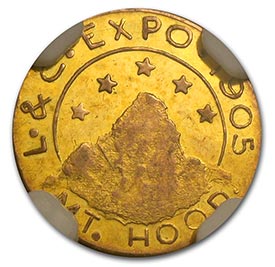
Oregon Gold (1849)
Territorial and private issues were common all the way through the Coinage Acts of 1857 and 1864, which banned private and foreign money from circulating alongside U.S.-minted currency. There were still private issues that circulated in Western states and territories like Utah and California even after this act. Some of these were certified by the U.S. government before official mints were put in place, while others only saw circulation for a limited period of time. Oregon saw some private issues created due to the return of miners who had traveled to California for the Gold Rush.
Oregon Gold Design
The history of early United States coins embraces a wide variety of money, not just coins minted within the United States itself. World coins saw common usage across the whole of the United States, and major denominations from countries like the Netherlands, France, and Spain were widely circulated through the 1850s. British coins were commonplace, not surprising considering the American colonies were under British rule. The bulk of coinage was English crowns, shilling and pence as well as the Spanish piece of eight (which laid the groundwork for the Silver dollar). This began to change as the U.S. started striking its own coins, but this currency still circulated alongside it.
Foreign coins were not the only circulating currency in the New World. Private issues were also available, and there were circulating coins created by some of the states in both colonial and post-colonial times. There are several major privacy issues that were created in the Americas and saw varying degrees of circulation. After the colonial era, many of these were Gold coins created to fill in the gaps in higher-denomination coinage. Gold private and regional issues saw use even after they technically became illegal, particularly out in the Western states.
“Private Gold” is defined by the Guide Book of United States Coins as “interesting necessity pieces of various shapes, denominations and degrees of intrinsic worth that were circulated in isolated areas of the United States by individuals, assayers, bankers and so on”.
Some issues were allowed under U.S. law. Provisional mints were established as private enterprises out in California and other new Western states. Out in the West and the territories, Precious Metals saw more circulation than they did back East. Eastern states were moving towards banknotes and base metal coins were starting to gain traction, but in the farther-flung areas, there were not the same established networks of value. That meant people gravitated to the things that they knew held value regardless: Gold and Silver.
Many Oregonians traveled to California to find Gold when the Gold Rush occurred, and as they returned home they brought Gold dust. Tradespeople were annoyed dealing with Gold dust as a medium of exchange. Gold was of variable quality and assay and weighing the dust rapidly led to frustration. The citizens petitioned for a new Gold coin.
The territorial legislature passed a resolution for a mint to create pure $5 and $10 Gold coins on February 16, 1849. Oregon had just been added to the United States as a territory, and when the governor arrived at the start of March he swiftly moved against the coinage act. He declared it unconstitutional.
This did not deter the Oregonians, though. Eight men created the Oregon Exchange Company and struck $5 and $10 coins in Oregon City according to the original specifications. All known examples are dated 1849. These are sometimes called “Beaver coins” because of their design, which had a beaver on the obverse.
Historical Significance
These Gold private issues are unique, as they were only possible in a very narrow window when Oregon had just become a territory.
Numismatic Value
These coins are expensive even in low grades, with the lowest going for tens of thousands of dollars and the highest going for multiple hundreds of thousands of dollars.
Expand your collection today and shop our assortment of Pre-1933 U.S. Gold Coins.

PCGS Products
You need the most up-to-date pricing on your coin collection. That’s why APMEX has partnered with PCGS, the premier grading authority in the world of rare coins, to bring you constantly updated pricing on collectibles and rarities. PCGS has been grading coins since 1986, bringing consistent standards of quality to a fractured industry. In the years since they have remained a source of reliable information on the current collectible and rare coin market.




